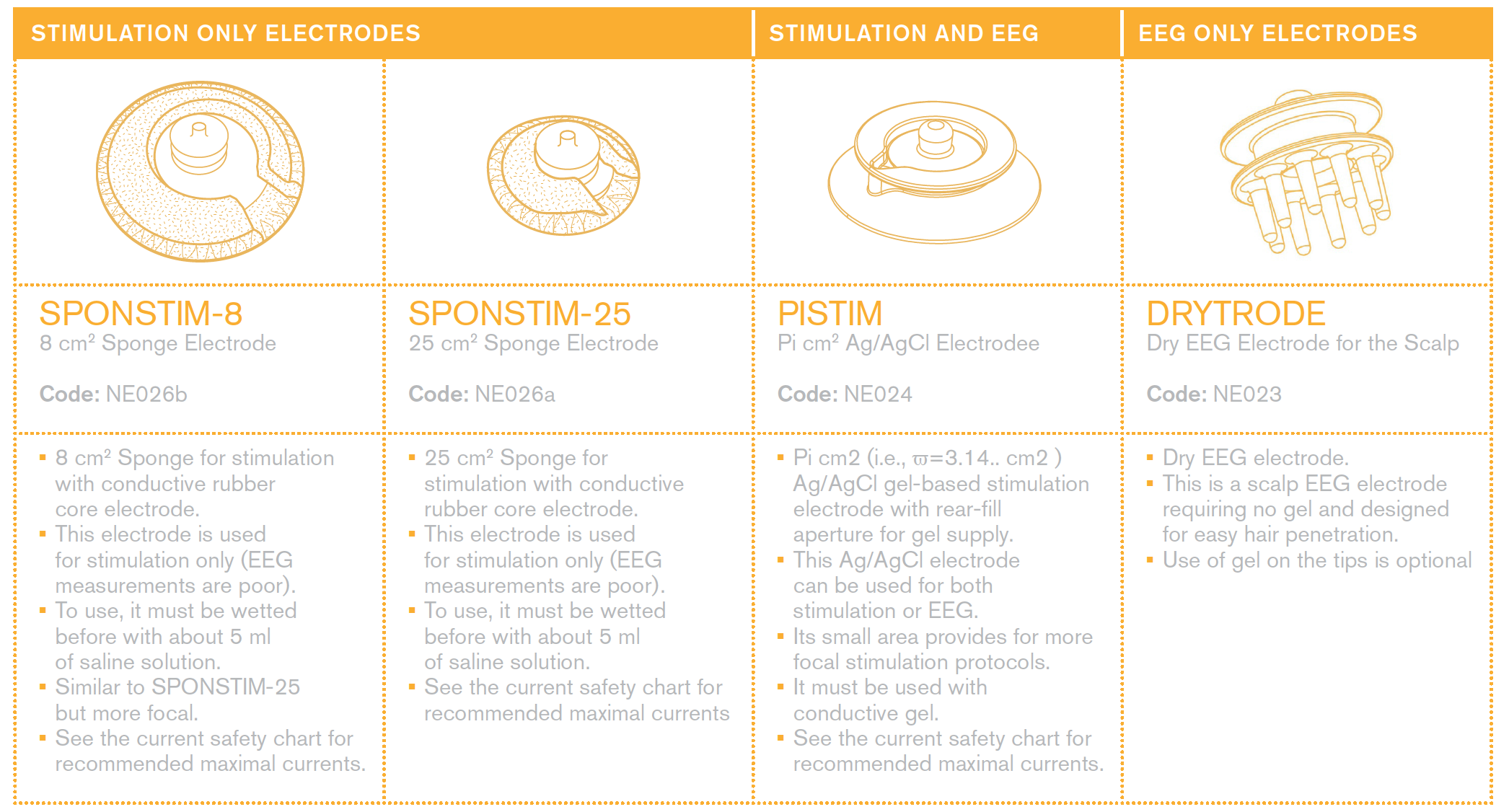Difference between revisions of "Tips & Tricks"
(→Caring for EEG electrodes) |
(→Caring for stimulation electrodes) |
||
| Line 76: | Line 76: | ||
[[File:electrodes3.png|200px|thumb|left|]] | [[File:electrodes3.png|200px|thumb|left|]] | ||
| − | It's important to rinse | + | It's important to rinse stimulation electrodes (sponges and Ag/AgCl alike) with water in order to remove the salts that might remain after drying. |
| + | |||
It is also recommended to dry the metal part to avoid salt on the connectors. | It is also recommended to dry the metal part to avoid salt on the connectors. | ||
Revision as of 16:19, 24 October 2013
Contents
Tips for EEG recording using Enobio or StarStim
In this page we provide some tips and tricks to work with our systems. Here are some useful resources you should also check:
- | StarStim tCS EEG recording (Jove)
- | A short introduction to NIC v1.2
- | Stimulation configuration with NIC v1.2
Plan your session well before starting
You should have a clear plan covering all the details in your recording session. Prepare to be patient. Setting up always takes a bit longer than expected, and when carrying out experiments ... the third time's the charm!
Where do you want to place the electrodes? For how long do you want to record? Do you have a good naming scheme for your EEG files? What data formats do you want to save? Do you need accelerometry data? Do you want a line filter applied to the data (if so 50 or 60 Hz?)?
Do you have an electrode referencing scheme planned ahead? You should include in your montage construct a solution for data referencing. With our systems, data will be recorded referenced to the device electrical ground (the CMS electrode), but for data analysis you should always reference the data to an electrode or to the electrode average. See, e.g., | this for more on referencing.
Place carefully the CMS and DRL electrodes
These two electrodes should go over the left or right mastoid (best to always stick to one side). First clean up the mastoid area where you are going to attach the DRL/CMS electrodes (using Sticktrode adhesive electrodes). You can use a paper napkin with some water or alcohol. Removing grease and dry skin will help you get good signal.
Stick the DRL/CMS electrodes close to each other, with the DRL on the bottom. These two Sticktrode electrodes should be close to each other but not touch. The CMS electrode should be on top and squarely on top of the mastoid bone. This will avoid contamination from blood vessels (ECG like signals).
Avoid loose wires
Try to have a tidy setup with few loose wires. Loose wires are more prone to creating noise from movement.
About EEG signal quality measures in NIC
As of NIC v1.2, EEG signal quality measures for each electrode are provided in real time.
If all the channels are in yellow or red zone, you may have an issue with the CMS/DRL electrodes (they create the ground for measurements, so if they are misplaced all the signals will be affected).
If an electrode is misbehaving, check that it has a good contact and, if possible, add more gel (you can reach the site from another hole in the cap).
Give a few minutes at the start for signals (electrochemistry) to stabilize.
Tips for great Stimulation sessions using StarStim
See the section above on placing well the DRL/CMS electrodes. They are also important for stimulation.
Using Sponge electrodes
Sponge electrodes are easy to use. You can place them on the cap and wet them (about 2-4 cubic cm of saline solution will do) prior placing the cap on the subject's head.
If you have impedance issues, rewet them from a side hole using a syringe. Be careful not to wet the cap.
Using Ag/AgCl Pi electrodes
Pi electrodes are also easy to use. You can place them on the cap and gel them (fill the electrode hole space and then some more) prior placing the cap on the subject's head.
If you have impedance issues, regel them from the electrode hole or a side hole using a syringe.
The impedance test
You should carry out an impedance test before launching a stimulation (at least for the first session if you have several on a row with the same subject). If impedance is too high for some electrode, rewet, regel and check cabling connections. The recheck impedance. Impedance should be in the "green" area to proceed well.
For safety, impedance is also checked by NIC while stimulation is ongoing. If the impedance is too high, the stimulation session will self-abort.
Everything about electrodes for EEG and stimulation
Please see the | Electrode User Manual for a description of our electrodes.
Caring for EEG electrodes
It's very important to remove all the gel from the electrodes (and cap!) carefully after a recording session using gel. You can do this with water.
Sunlight exposure or contact with metals might damage the electrodes.
With our wet electrodes some discoloration may occur after a few uses. It is normal and does not affect data quality.
Caring for stimulation electrodes
It's important to rinse stimulation electrodes (sponges and Ag/AgCl alike) with water in order to remove the salts that might remain after drying.
It is also recommended to dry the metal part to avoid salt on the connectors.
In case there salt accumulating at the metallic part, it can be washed with some vinegar to remove it.
Electrode duration
There's no a fixed statement of number of uses or hours of recording for the EEG electrodes. It depends on how are they cleaned or stored.
The electrode degradation can be seen when the electrodes have too much noise when recording.


